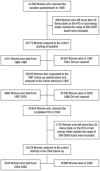Dietary supplements and mortality rate in older women: the Iowa Women's Health Study
- PMID: 21987192
- PMCID: PMC4114071
- DOI: 10.1001/archinternmed.2011.445
Dietary supplements and mortality rate in older women: the Iowa Women's Health Study
Abstract
Background: Although dietary supplements are commonly taken to prevent chronic disease, the long-term health consequences of many compounds are unknown.
Methods: We assessed the use of vitamin and mineral supplements in relation to total mortality in 38,772 older women in the Iowa Women's Health Study; mean age was 61.6 years at baseline in 1986. Supplement use was self-reported in 1986, 1997, and 2004. Through December 31, 2008, a total of 15,594 deaths (40.2%) were identified through the State Health Registry of Iowa and the National Death Index.
Results: In multivariable adjusted proportional hazards regression models, the use of multivitamins (hazard ratio, 1.06; 95% CI, 1.02-1.10; absolute risk increase, 2.4%), vitamin B(6) (1.10; 1.01-1.21; 4.1%), folic acid (1.15; 1.00-1.32; 5.9%), iron (1.10; 1.03-1.17; 3.9%), magnesium (1.08; 1.01-1.15; 3.6%), zinc (1.08; 1.01-1.15; 3.0%), and copper (1.45; 1.20-1.75; 18.0%) were associated with increased risk of total mortality when compared with corresponding nonuse. Use of calcium was inversely related (hazard ratio, 0.91; 95% confidence interval, 0.88-0.94; absolute risk reduction, 3.8%). Findings for iron and calcium were replicated in separate, shorter-term analyses (10-year, 6-year, and 4-year follow-up), each with approximately 15% of the original participants having died, starting in 1986, 1997, and 2004.
Conclusions: In older women, several commonly used dietary vitamin and mineral supplements may be associated with increased total mortality risk; this association is strongest with supplemental iron. In contrast to the findings of many studies, calcium is associated with decreased risk.
Figures
Comment in
-
Vitamin and mineral supplement use in relation to all-cause mortality in the Iowa Women's Health Study.Arch Intern Med. 2011 Oct 10;171(18):1633-4. doi: 10.1001/archinternmed.2011.459. Arch Intern Med. 2011. PMID: 21987193 No abstract available.
-
Vitamin supplements: more cost than value.Arch Intern Med. 2011 Oct 10;171(18):1634-5. doi: 10.1001/archinternmed.2011.422. Arch Intern Med. 2011. PMID: 21987194 No abstract available.
-
Dietary supplements and mortality.Arch Intern Med. 2012 Mar 12;172(5):447-8; author reply 449-50. doi: 10.1001/archinternmed.2011.1858. Arch Intern Med. 2012. PMID: 22412119 No abstract available.
-
Dietary supplements and altered mortality: a conflict of evolutionary medicine.Arch Intern Med. 2012 Mar 12;172(5):448-9; author reply 449-50. doi: 10.1001/archinternmed.2011.1861. Arch Intern Med. 2012. PMID: 22412120 No abstract available.
-
The importance of translating research skillfully to benefit the public.Arch Intern Med. 2012 Mar 12;172(5):449; author reply 449-50. doi: 10.1001/archinternmed.2011.1864. Arch Intern Med. 2012. PMID: 22412121 No abstract available.
-
Various vitamin and mineral supplements are observed to increase mortality risk in older women, with the exception of calcium, which decreases risk.Evid Based Nurs. 2012 Jul;15(3):79. doi: 10.1136/ebnurs-2011-100438. Epub 2012 Mar 22. Evid Based Nurs. 2012. PMID: 22440757 No abstract available.
-
An industry perspective: dietary supplements and mortality rates in older women.J Diet Suppl. 2013 Jun;10(2):85-92. doi: 10.3109/19390211.2013.783661. Epub 2013 May 16. J Diet Suppl. 2013. PMID: 23679573
References
-
- NIH State-of-the-Science Conference Statement on Multivitamin/Mineral Supplements and Chronic Disease Prevention. Ann Intern Med. 2006;145:364–371. - PubMed
-
- Radimer K, Bindewald B, Hughes J, Ervin B, Swanson C, Picciano MF. Dietary supplement use by US adults: data from the National Health and Nutrition Examination Survey, 1999-2000. Am J Epidemiol. 2004;160(4):339–349. - PubMed
-
- Silver HJ. Oral strategies to supplement older adults' dietary intakes: comparing the evidence. Nutr Rev. 2009;67:21–31. - PubMed
-
- Watkins ML, Erickson JD, Thun MJ, Mulinare J, Heath CW., Jr Multivitamin use and mortality in a large prospective study. Am J Epidemiol. 2000;152(2):149–162. - PubMed
Publication types
MeSH terms
Grants and funding
LinkOut - more resources
Full Text Sources
Medical


